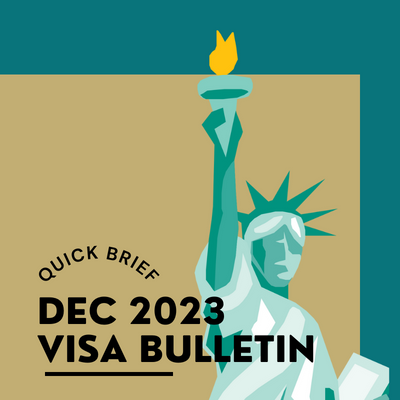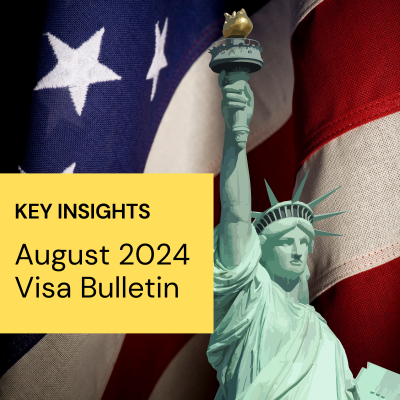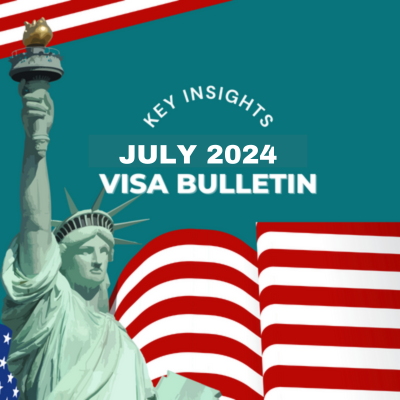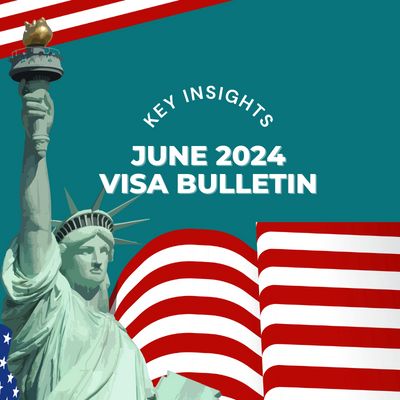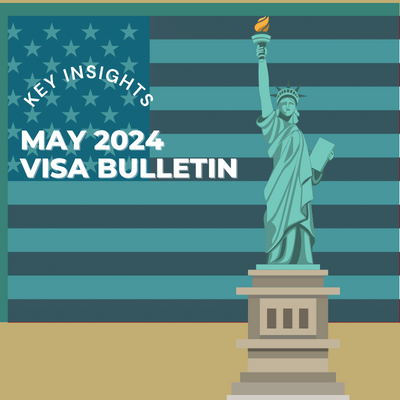Visa Bulletin December 2023 Shows Very little Changes- Quick OverView
A-Statutory Numbers For Preference Immigrant Visas
This Visa bulletin provides a brief December visa availability overview, including the “Final Action Dates” and “Dates for Filing Applications.” It informs immigrant visa applicants about the timeline for notification to gather and submit the necessary documentation to the National Visa Center.
Unless stated otherwise on the USCIS website at www.uscis.gov/visabulletininfo, individuals wishing to submit adjustment of status applications with USCIS should refer to the “Final Action Dates” charts below to determine the appropriate filing period. When USCIS confirms that more immigrant visas are available for the fiscal year than applicants, the website will indicate that applicants can utilize the “Dates for Filing Visa Applications” charts provided in this Bulletin—no changes in the EB-1, EB-2, and EB-3 employment categories Or in the Family-based categories. USCIS has indicated that the Dates for the filing table will be used.
1-Procedures for determining dates. Consular officers and USCIS play vital roles in the visa application process. Consular officers are responsible for reporting documentarily qualified applicants for numerically limited visas to the Department of State, while USCIS handles applicants for adjustment of status. Visitor allocations are made chronologically based on reported priority dates to ensure fairness. The charts below reflect grants made based on demand received by November 2nd. In cases where demand exceeds the available visas, the category or foreign state is considered oversubscribed. For oversubscribed classes, the final action date is determined by the priority date of the first applicant who couldn’t be reached within the numerical limits. If a last action date needs to be retrogressed during the monthly allocation process, only supplemental requests for numbers with priority dates falling within the new final action date will be honored. Please note that if an annual limit is reached at any time, the preference category will be deemed “unavailable” immediately. Consequently, no further requests for numbers would be honored.
2- The visa limit for family-sponsored preference immigrants in fiscal year 2024, as per Section 201 of the Immigration and Nationality Act (INA), is 226,000. The annual worldwide level for employment-based preference immigrants is a minimum of 140,000. According to Section 202, the per-country limit for preference immigrants is 7% of the total annual limits for family-sponsored and employment-based preferences, which amounts to 25,620 visas. Additionally, there is a dependent area limit of 2%, equivalent to 7,320 tickets.
3- INA Section 203(e) ensures eligible immigrants receive family-sponsored and employment-based preference visas according to their filed petitions. Similarly, Section 203(d) grants spouses and children of preference immigrants the same status and consideration order if they accompany or follow the principal immigrant. Section 202(e) prorates visa allocations for a foreign state or dependent area when visa issuances exceed the per-country limit. These provisions apply to oversubscribed chargeability areas, including mainland-born CHINA, INDIA, MEXICO, and the PHILIPPINES. Explore the visa process further for these regions.
4- Section 203(a) of the Immigration and Nationality Act (INA) outlines the various preference classes for allocating Family-sponsored immigrant visas As follows:
Family-Sponsored Preferences
First: (F1) Unmarried Sons and Daughters of U.S. Citizens: 23,400 plus any numbers not required for fourth preference.
Second: Spouses and Children, and Unmarried Sons and Daughters of Permanent Residents: 114,200, plus the number (if any) by which the worldwide family preference level exceeds 226,000, plus any unused first preference numbers:
A. (F2A) Spouses and Children of Permanent Residents: 77% of the overall second preference limitation, of which 75% are exempt from the per-country limit;
B. (F2B) Unmarried Sons and Daughters (21 years of age or older) of Permanent Residents: 23% of the overall second preference limitation.
Third: (F3) Married Sons and Daughters of U.S. Citizens: 23,400, plus any numbers not required by first and second preferences.
Fourth: (F4) Brothers and Sisters of Adult U.S. Citizens: 65,000, plus any numbers not required by first three preferences.
A-Final Action Dates for Family-Sponsored Preference Cases
The following chart displays the date listings for each class, indicating if the class is oversubscribed (refer to paragraph 1). The letter “C” signifies that the numbers are authorized for issuance to all qualified applicants, while “U” indicates that the numbers are unauthorized for issuance. Please note that numbers are only authorized for applicants with a priority date prior to the final action date listed below.
| Family- Sponsored |
All Chargeability Areas Except Those Listed Separately |
China-mainland born |
India | Mexico | Philippines |
|---|---|---|---|---|---|
| F1 | 01JAN15 | 01JAN15 | 01JAN15 | 01MAY01 | 01MAR12 |
| F2A | 08FEB19 | 08FEB19 | 08FEB19 | 01FEB19 | 08FEB19 |
| F2B | 22SEP15 | 22SEP15 | 22SEP15 | 01MAY02 | 22OCT11 |
| F3 | 08JAN09 | 08JAN09 | 08JAN09 | 22MAR98 | 08JUN02 |
| F4 | 22APR07 | 22APR07 | 08OCT05 | 15SEP00 | 22AUG02 |
In December, applicants from all countries with priority dates prior to 01FEB19 are eligible for F2A visa issuance. This exemption applies to F2A numbers that are not subject to per-country limits. However, F2A numbers subject to per-country limits can be issued to applicants from all countries except Mexico, provided their priority dates are between 01FEB19 and 08FEB19. It’s important to note that all F2A numbers allocated to Mexico are exempt from the per-country limit.
B-Dates for Filing Family-Sponsored Visa Applications
The following chart provides key dates for filing visa applications, urging immediate action in the application process. Immigrant visa applicants with a priority date that precedes the application date listed below should submit the necessary documents to the Department of State’s National Visa Center, upon receiving a notification with detailed instructions. For oversubscribed categories, the application date is determined by the priority date of the first applicant unable to submit documentation to the National Visa Center. If a category is marked as “current,” applicants in that category can file applications regardless of their priority date.
The “C” designation signifies that the category is current and applications can be filed irrespective of the applicant’s priority date. A specific date listed for any category means that only applicants with a priority date earlier than the listed date can submit their application.
For information regarding the use of this chart for filing adjustment of status applications with the U.S. Citizenship and Immigration Services (USCIS) this month, please visit www.uscis.gov/visabulletininfo instead of referring to the chart mentioned in paragraph 4.A.
| Family- Sponsored |
All Chargeability Areas Except Those Listed Separately |
China-mainland born |
India | Mexico | Philippines |
|---|---|---|---|---|---|
| F1 | 01SEP17 | 01SEP17 | 01SEP17 | 01APR05 | 22APR15 |
| F2A | 01SEP23 | 01SEP23 | 01SEP23 | 01SEP23 | 01SEP23 |
| F2B | 01JAN17 | 01JAN17 | 01JAN17 | 01AUG04 | 01OCT13 |
| F3 | 01MAR10 | 01MAR10 | 01MAR10 | 15JUN01 | 08NOV03 |
| F4 | 01MAR08 | 01MAR08 | 22FEB06 | 15APR01 | 22APR04 |
Employment-Based Preferences
First: Priority Workers: 28.6% of the worldwide employment-based preference level, plus any numbers not required for fourth and fifth preferences.
Second: Members of the Professions Holding Advanced Degrees or Persons of Exceptional Ability: 28.6% of the worldwide employment-based preference level, plus any numbers not required by first preference.
Third: Skilled Workers, Professionals, and Other Workers: 28.6% of the worldwide level, plus any numbers not required by first and second preferences, not more than 10,000 of which to “*Other Workers”.
Fourth: Certain Special Immigrants: 7.1% of the worldwide level.
Fifth: Employment Creation: A significant 7.1% of the global level is dedicated to visas, with 32% exclusively allocated for various categories. Out of this, 20% is reserved for qualified immigrants who invest in rural areas, while 10% is set aside for those investing in high unemployment areas. Additionally, 2% of visas are specifically designated for qualified immigrants investing in infrastructure projects. The remaining 68% are available for all other eligible immigrants seeking opportunities.
5. Section 203(b) of the INA prescribes preference classes for allotment of Employment-based immigrant visas as follows:
A-Final Action Dates for Employment-Based Preference Cases
The chart below provides filing dates for visa applications that require immediate action in the application process. Immigrant visa applicants with a priority date earlier than the listed application date can submit their necessary documents to the Department of State’s National Visa Center. Once notified by the National Visa Center, applicants should follow the detailed instructions. For oversubscribed categories, the application date is determined by the priority date of the first applicant unable to submit documentation to the National Visa Center. If a category is labeled as “current,” applicants can file their applications regardless of their priority date.
The “C” designation indicates that the category is open for filing applications, regardless of the applicant’s priority date. A specific date listed for any category means that only applicants with a priority date before the listed date are eligible to file their application.
For information on whether USCIS has approved the use of this chart for filing adjustment of status applications with USCIS this month, please visit www.uscis.gov/visabulletininfo.
| Employment- based |
All Chargeability Areas Except Those Listed Separately |
China-mainland born |
India | Mexico | Philippines |
|---|---|---|---|---|---|
| 1st | C | 15FEB22 | 01JAN17 | C | C |
| 2nd | 15JUL22 | 22OCT19 | 01JAN12 | 15JUL22 | 15JUL22 |
| 3rd | 01DEC21 | 22JAN20 | 01MAY12 | 01DEC21 | 01DEC21 |
| Other Workers | 01AUG20 | 01JAN16 | 01MAY12 | 01AUG20 | 01MAY20 |
| 4th | 01JAN19 | 01JAN19 | 01JAN19 | 01JAN19 | 01JAN19 |
| Certain Religious Workers | U | U | U | U | U |
| 5th Unreserved (including C5, T5, I5, R5) |
C | 01OCT15 | 15DEC18 | C | C |
| 5th Set Aside: (Rural – 20%) |
C | C | C | C | C |
| 5th Set Aside: (High Unemployment – 10%) |
C | C | C | C | C |
| 5th Set Aside: (Infrastructure – 2%) |
C | C | C | C | C |
*The Employment Third Preference Other Workers Category, established under the Nicaraguan and Central American Relief Act (NACARA), offers opportunities for individuals seeking employment visas. As per Section 203(e), this category underwent amendments through Pub. L. 105-139. According to the provisions, once the Employment Third Preference Other Worker (EW) cut-off date aligns with the latest EW petition approved before November 19, 1997, the available 10,000 EW numbers for a fiscal year will gradually decrease by up to 5,000 annually from the following fiscal year onwards. This reduction is necessary to accommodate the adjustments under the NACARA program. The reduction began in Fiscal Year 2002 when the EW final action date reached November 19, 1997 during Fiscal Year 2001. It is important to note that, for Fiscal Year 2024, this reduction will be limited to approximately 150.
B- Dates For Filing Of Employment-Based Visa Applications
The chart below provides filing dates for visa applications that require immediate action in the application process. Immigrant visa applicants with a priority date earlier than the listed application date can submit their necessary documents to the Department of State’s National Visa Center. Once notified by the National Visa Center, applicants should follow the detailed instructions provided. For oversubscribed categories, the application date is determined by the priority date of the first applicant unable to submit documentation to the National Visa Center. If a category is labeled as “current,” applicants in that category can file their applications regardless of their priority date.
The “C” designation indicates that the category is currently open for filing applications, regardless of the applicant’s priority date. A specific date listed for any category means that only applicants with a priority date prior to the listed date are eligible to file their application.
For information on whether USCIS has approved the use of this chart for filing adjustment of status applications with USCIS this month, please visit www.uscis.gov/visabulletininfo.
| Employment- based |
All Chargeability Areas Except Those Listed Separately |
China-mainland born |
India | Mexico | Philippines |
|---|---|---|---|---|---|
| 1st | C | 01 AUG 22 | 01 JUL 19 | C | C |
| 2nd | 01JAN23 | 01JAN20 | 15MAY12 | 01JAN23 | 01JAN23 |
| 3rd | 01FEB23 | 01SEP20 | 01AUG12 | 01FEB23 | 01JAN23 |
| Other Workers | 15DEC20 | 01JUN17 | 01AUG12 | 15DEC20 | 15MAY20 |
| 4th | 01MAR19 | 01MAR19 | 01MAR19 | 01MAR19 | 01MAR19 |
| Certain Religious Workers | 01MAR19 | 01MAR19 | 01MAR19 | 01MAR19 | 01MAR19 |
| 5th Unreserved (including C5, T5, I5, R5) |
C | 01JAN17 | 01APR22 | C | C |
| 5th Set Aside: (Rural – 20%) |
C | C | C | C | C |
| 5th Set Aside: (High Unemployment – 10%) |
C | C | C | C | C |
| 5th Set Aside: (Infrastructure – 2%) |
C | C | C | C | C |
B- Diversity Immigrant (DV) Category For December
Section 203(c) of the INA offers up to 55,000 immigrant visas per fiscal year, creating opportunities for individuals from countries with low admissions in the past five years to immigrate. Under the NACARA program, starting with DV-99, up to 5,000 of the 55,000 diversity visas allotted annually will be reserved. Consequently, the annual limit for DV-2024 will be reduced to around 54,850. These DV visas are distributed among six geographic regions, with no single country receiving more than seven percent of the available diversity visas in a given year.
In December, immigrant numbers in the DV category are accessible to qualified DV-2024 applicants from all regions and eligible countries, subject to allocation cut-off numbers. Applicants with DV regional lottery rank numbers below the specified allocation cut-off number are eligible for visas.
| Region | All DV Chargeability Areas Except Those Listed Separately |
|
|---|---|---|
| Africa | 11,000 | Except: Algeria 10,500 Egypt 10,000 Morocco 10,000 |
| Asia | 3,000 | Except: Iran 2,800 Nepal 2,500 |
| Europe | 6,000 | Except: Russia 5,900 Uzbekistan 3,000 |
| North America (Bahamas) | 5 | |
| Oceania | 450 | |
| South America, And The Caribbean | 600 |
The entitlement to immigrant status in the DV category for the search term “visa” only lasts until the end of the fiscal year in which the applicant is selected. For the DV-2024 program, the entitlement ends on September 30, 2024. After this date, DV visas will not be issued to DV-2024 applicants. Similarly, spouses and children who are accompanying or following to join DV-2024 principals are only entitled to derivative DV status until September 30, 2024. It is important to note that DV visas may not be available until the end of FY-2024. The visa numbers could be exhausted before September 30.
C- The Diversity (DV) Immigrant Category Rank Cut-Offs Will Apply In January.
In January, immigrant numbers for the DV category are accessible to eligible DV-2024 applicants from all regions and eligible countries. Please note that visas are only available for applicants with DV regional lottery rank numbers BELOW the specified allocation cut-off number.
| Region | All DV Chargeability Areas Except Those Listed Separately |
|
|---|---|---|
| Africa | 22,000 | Except: Algeria 15,000 Egypt 15,000 Morocco 20,000 |
| Asia | 5,500 | Except: Algeria 15,000 Egypt 15,000 Morocco 20,000 |
| Europe | 12,000 | Except: Russia 11,500 Uzbekistan 4,750 |
| North America (Bahamas) | 5 | |
| Oceania | 650 | |
| South America, And The Caribbean | 1000 |
D- Scheduled Expiration of One The Employment Fourth Preference (Sr) Religious Workers Category
According to H.R. 5860, signed on September 30, 2023, the non-minister special immigrant program for visa expires on November 17, 2023. After midnight on November 16, 2023, no SR visas can be issued overseas or have final action taken on adjustment of status cases. Visas issued before that date will only be valid until November 16, 2023, and all individuals looking to enter the United States under the non-minister special immigrant category must be admitted by midnight on November 16, 2023.
For the month of December, the SR category is designated as “Unavailable” for all countries. However, if there is legislative action to extend the category, it is likely to become available immediately. In the case of an extension, the category will follow the same final action dates as the other Employment Fourth Preference categories based on the applicable foreign state of chargeability.
Find the most up-to-date visa processing details at U.S. Embassies and Consulates by visiting the Bureau of Consular Affairs website at Travel.State.Gov.
Next Visa Bulletin: The January 2024 Visa Bulletin is expected to bring significant changes as new visa allocations for FY 2024 become available.
The Law Offices of Prashanthi Reddy PLLC will keep updating their Immigration blog with new information as it arises.

